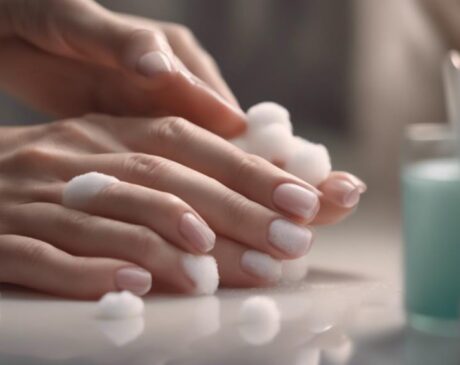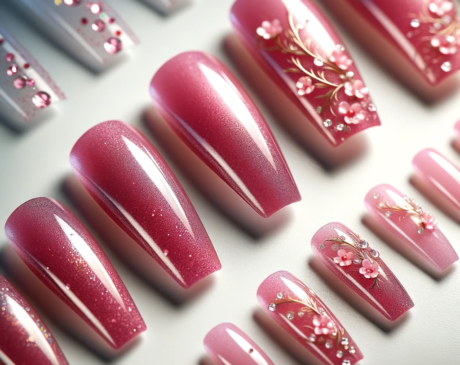Can You Remove Pressure from Your Nails at Any Time?

One of the most crucial aspects that is often overlooked when it comes to press-on nails is the importance of removing them properly. Careless removal of these artificial nails can not only damage press-on nails and make them unusable for future use, but more importantly, it can damage your natural nails. Incorrect removal techniques can lead to problems such as thinning of the nails, surface damage, and in severe cases, even infection. This section of our article emphasizes the need to understand and follow the correct procedure for removing press-on nails to ensure nail health and keep the possibility of reusing press-on nails open.
Understanding Press-On Nails
What are Press-On Nails?
Press-on nails are a form of artificial nail designed to be easy and quick to apply. They come in a variety of compositions, the most common being plastic or acrylic. These nails are pre-molded and usually come with a pre-applied adhesive backing. They are available in types ranging from full sets to tips to accommodate different nail sizes and shapes.
The composition of press-on nails is a key factor in determining their durability, flexibility, and appearance. High-quality press-on nails mimic the look and feel of professional acrylic nails, providing a glossy and polished finish. Some types are even designed to be paintable, allowing for customization.
Benefits of Press-On Nails
The main benefits of press-on nails are their convenience and versatility. These nails are the preferred solution for those who want the look of a professional manicure but don’t want to spend the time or expense of going to a salon. They are especially beneficial for last-minute events or for individuals who don’t like to use acrylics or gels for long periods of time.
Versatility is another significant benefit. Press-on nails come in a variety of designs, lengths, and shapes. From classic French manicures to modern matte finishes and sophisticated designs, there is something for every preference and occasion. This versatility allows users to experiment with different looks without the risk of nail damage caused by long-term commitment or traditional acrylics.
The Right Time to Remove Press-On Nails
Signs that it’s time to remove
Determining the right time to remove press-on nails is key to maintaining the health of your natural nails and the integrity of your press-on nails. Typically, press-on nails can last anywhere from a few days to a few weeks, depending on the quality of the nail and how it is used. Signs that it’s time to remove them include noticeable lifting of the edges, visible nail regrowth, or any signs of damage or discoloration on the press-on nail itself.
Factors affecting the timing of removal
The timing of press-on nail removal is not just about aesthetics. It also involves the health and growth of your natural nails. If left on for too long, press-on nails can restrict the natural growth of your nails and may even lead to moisture retention, which can lead to weakened nails or fungal infections.
Additionally, personal habits and activities can affect how long your press-on nails last. Frequent hand washing, exposure to water, and the types of daily activities you engage in can affect the adhesion and overall wear resistance of your press-on nails. It’s important to weigh these factors and determine the best time to remove them so you can ensure the health of your natural nails while taking full advantage of your press-on manicure.
Safe removal of press-on nails
Tools and materials needed
Before starting the removal process, it is important to have the right tools and materials on hand. This ensures that the removal process is as gentle and effective as possible, minimizing potential damage to your natural nails. Below is a list of the necessary items:
- Nail polish remover: choose an acetone-based remover for effective results, especially if your press-on nails are particularly stubborn.
- Cotton balls or pads: use with nail polish remover.
- Warm water: helps soften nails and glue.
- Bowl: for soaking nails in warm water.
- Nail file: preferably a fine-grained file.
- Cuticle pusher or orange stick: for gently lifting press-on nails.
- Nail clippers (optional): in case you need to trim your natural nails after removal.
- Nourishing nail polish or moisturizer: essential for aftercare.
Step-by-step removal process
Follow the detailed steps below to safely remove press-on nails:
- File the top layer: gently file the top layer of the press-on nail. This helps break the seal and makes the removal process easier.
- SOAK IN WARM WATER: Soak the nail in warm water for approximately 10-15 minutes. This will help loosen the glue.
- USE NAIL POLISH REMOVER: Moisten a cotton ball with an acetone-based nail polish remover and apply it to the nail. You can also wrap the nail in foil to hold the cotton ball in place.
- Gently lift the edges: after a few minutes, use a cuticle pusher or orange stick to gently lift the edges of your press-on nails. If they don’t come off easily, soak them longer.
- Repeat if necessary: repeat the soaking and lifting process until all nails have been safely removed.
Post-removal nail care
Natural Nail Care After Removal
After removing press-on nails, your natural nails will need some careful attention. Here’s how to take care of them:
- Clean and dry: make sure your nails are thoroughly cleaned and dry after removal.
- Moisturize: apply a nourishing nail polish or moisturizer to hydrate your nails and cuticles.
- Avoid harsh chemicals: Keep your nails away from harsh chemicals for a few days for now.
When to Reapply New Press-On Stickers
It’s important to let your nails breathe and recover before reapplying a new press-on. Ideally, wait at least a week or two, especially if you notice any signs of damage or weakness in your natural nails.
Common mistakes to avoid
Do’s and don’ts when removing your nails
Do:
- Take your time: rushing the process can cause damage.
- Use the right tools: this ensures safe and effective removal.
DON’T:
- Peel off your nails: this removes your natural nail layer.
- Use excessive force: if the nail is resistant, resume soaking it for longer.
Professional Vs. DIY Removal
When to seek professional help
While DIY methods are usually sufficient to remove press-on nails, in some cases it is advisable to seek professional help. This is especially true in the following complex situations:
- Nail damage is evident: if your natural nails are showing signs of damage or weakness, a professional can remove press-on nails to minimize further damage.
- Resistant nails: if the press-on nails are particularly stubborn and difficult to remove with at-home removal methods, a nail technician can use specialized tools and techniques to safely remove them.
- Infections or allergies: If a nail infection or allergic reaction occurs, it’s vital to consult a professional to prevent the condition from worsening.
Benefits of DIY Removal
DIY removal of press-on nails has its benefits, mainly in terms of cost and convenience:
- Cost-effective: removing nails at home saves on trips to the salon.
- Convenience: you can remove them at home at your own pace and comfort.
- Learning experience: DIY removal gives you a better understanding of nail care and the features of different nail products.
While press-on nails offer a versatile and convenient option for an impressive manicure, it’s crucial to understand the proper techniques for their application, removal, and aftercare. Whether you choose the DIY method or professional assistance, it’s crucial to prioritize the health and safety of your natural nails. Remember that removing nail polish properly, hydrating regularly, and giving your nails time to recover between polish applications are important steps in keeping your nails healthy and beautiful.
Frequently Asked Questions
Can frequent removal of press-on nails damage natural nails?
Yes, frequent and incorrect removal of press-on nails can damage natural nails. It can lead to thinning, brittleness, and breakage. It is important to follow proper removal techniques and allow your nails time to recover between applications.
How long should I wait before reapplying press-on nails?
It is recommended to wait at least a week or two before reapplying press-on nails. This waiting period allows your natural nails to recover and regain strength.
Is it safe to remove press-on nails at home?
Yes, removing press-on nails at home is usually safe as long as you follow the correct procedure and use the right tools. Be gentle and patient during the process to avoid damaging your natural nails.
Can I reuse the nails after removal?
Yes, you can reuse press-on nails if they are still in good condition and have not been damaged during the removal process. Clean them thoroughly and store them properly for future use.
What are the signs that a press stud needs to be removed?
Signs that it’s time to remove press-on nails include visible lifting of the edges, visible nail regrowth, discoloration, and any damage to the nails themselves.




